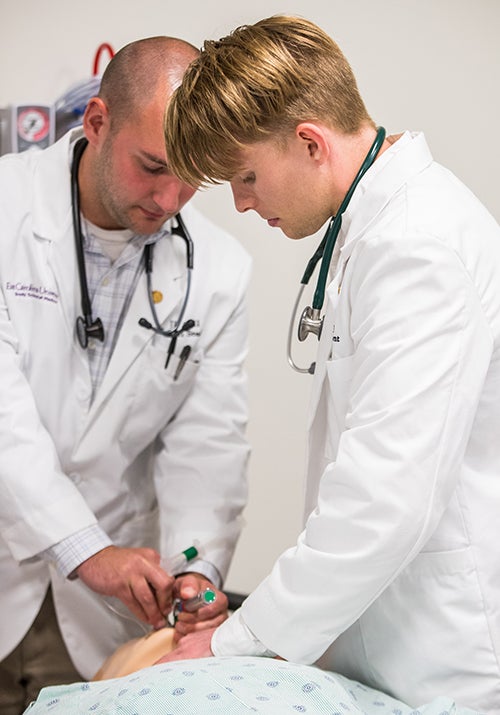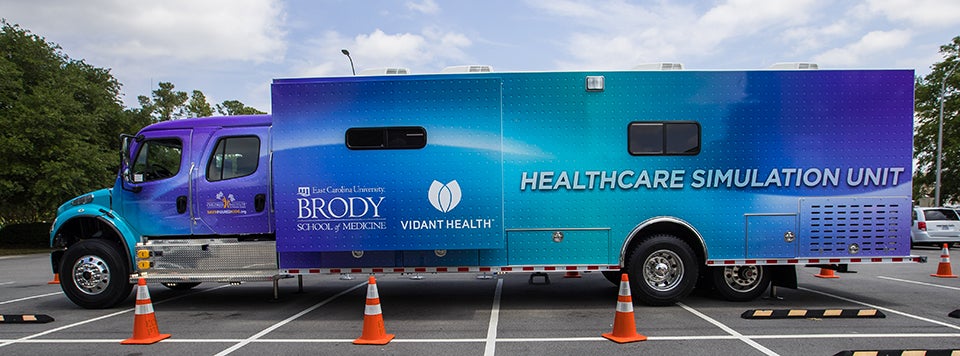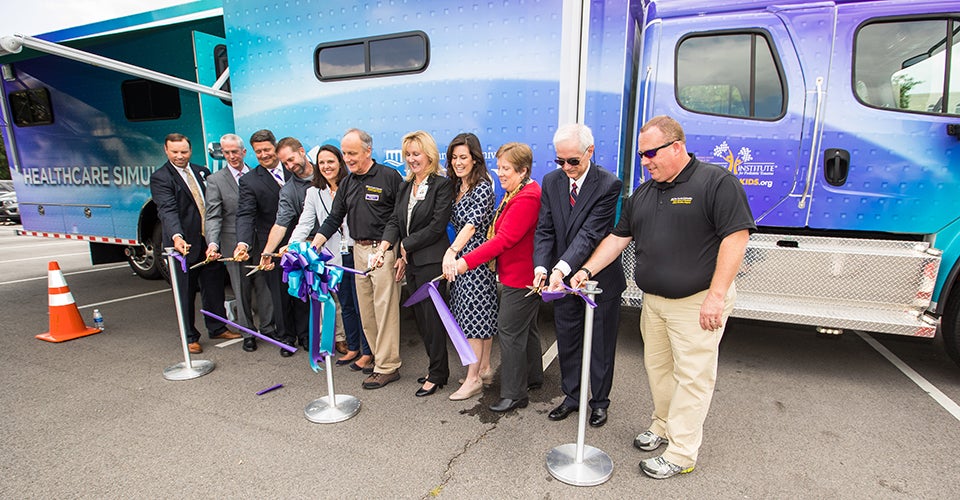MOBILE SIMULATION
Health care training hits the road
The opportunity for students at East Carolina University’s Brody School of Medicine to learn through simulation has grown rapidly since 2004, when the school got its first mannequin.
“The technology has advanced over the years and allows us to do much more,” said Dr. Walter “Skip” Robey III, Brody’s assistant dean for simulation and safety education, and director of the Interprofessional Clinical Simulation Center.
This week, the simulation center unveiled its new Mobile Healthcare Simulation Unit, a vehicle designed to take training and continuing education opportunities on the road to reach medical professionals throughout eastern North Carolina.
The mobile simulation unit, built by Rosenbauer, is one of only nine in the country and the only one in the southeast. It contains a realistic, simulated, fully equipped hospital resuscitation bay, an additional ambulance compartment, a control area and video debriefing capability. The interior can be converted into a classroom setting to accommodate a variety of educational activities.

The vehicle includes a fully equipped hospital resuscitation bay and high-fidelity mannequins.
The high-fidelity mannequins can simulate numerous situations that would be encountered in a clinical setting, said Dave Schiller, operations and simulations manager. From a five-year-old with a leg injury to a female giving birth, they expose trainees to the entire spectrum of medical situations.
“Simulation is a bridge between the classroom and real-life experiences,” said Robey. “It allows medical professionals to learn, train and rehearse together in an environment that does not compromise patient safety.”
By recording each simulated scenario, said Dr. Kim Crickmore, vice president of the James and Connie Maynard Children’s Hospital at Vidant Medical Center, “you’re able to go back and review, and learn from your actions. This is important not just from an academic standpoint, but also because it’s the promise that we make to our patients and families to give them the best that we have.”
The Interprofessional Clinical Simulation Program is a collaboration between the medical school and Vidant’s Center for Learning and Performance. Last year the center logged 7,500 learner encounters, including students and health care professionals from Brody, the ECU College of Allied Health Sciences, the ECU School of Dental Medicine and Vidant. The 7,500-square-foot center encompasses 14 simulation rooms and now offers the mobile unit.
Educational programs include continuing medical education, interprofessional teamwork and communication skills and practice for clinical encounters and medical procedures, Robey said. “Our goal is to have everyone who’s at the bedside get to practice together. … If it’s going to happen at the bedside we have to do it here, and do it together.”
Dr. Elizabeth Baxley, senior associate dean for academic affairs at Brody, said that every ECU medical student goes through the simulation program at least 28 times, practicing both basic and highly specialized skills. The interprofessional nature of the simulation center, she said, “ensures that health professionals – doctors, nurses, therapists, first responders – who work side by side together each day are equipped with the knowledge and skills they need to deliver safe and effective care.”

Simulation allows health care providers to learn and practice in a low-risk environment.
Simulation, said Dr. Nicholas Benson, Brody’s interim dean, allows students and health care professionals to practice and make mistakes without endangering patients, which builds confidence and improves technique. That way, he said, “when you are at the bedside, you have the ability to do that magic that makes patients better and helps their lives. That’s what this work is all about.”
The mobile unit expands the simulation center’s reach throughout the 29 counties served by Brody and Vidant Medical Center. Dr. Shannon Longshore, clinical assistant professor of pediatric surgery at Brody, said the mobile unit will have a tremendous impact on patients throughout the region by providing simulation training to health care providers at the 20 hospitals that refer trauma patients to Vidant.
“They can practice over and over,” she said, “without the anxiety of a live patient.”
They can also get that training near where they live and work, without having to travel to Greenville, helping alleviate staffing issues.
The $500,000 vehicle was funded through a one-time allocation of funds from the state. Programming is supported by a grant from the Childress Institute for Pediatric Trauma to provide pediatric trauma training to regional hospitals in eastern North Carolina.

The $500,000 vehicle was paid for with state funds; programming is supported by the Childress Institute for Pediatric Trauma.
